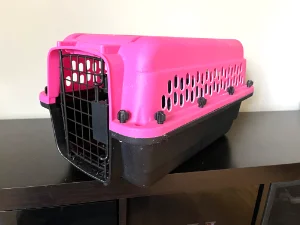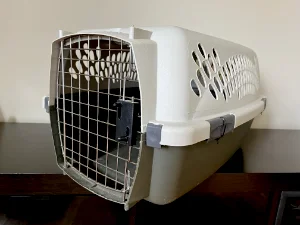Safely Getting your cat from A to B
If I had a dollar every time someone lost their cat to a cat carrier failure, I’d be able to afford all kinds of vet care for rescues. The sad fact is even with the best intentions, overlooking details when buying cat carriers can spell disaster. Even worse is not bothering to transport cats in carriers and risking the cat getting away in unfamiliar territory.
why transport cats in carriers?
For cats, watching the world go by at unnatural speeds can be frightening. Couple that with the sound of traffic and summer heat or winter cold and you have a recipe for a cat that wants to escape at all costs.
Your cat’s safety, your safety, and the safety of others on the road, are at stake when you need to take your cat on a road trip. Even a short drive to the vet can be a harrowing situation for both cat and driver. Many cats are not good travelers. They often meow from the minute you put them into a carrier all the way to your destination. For this reason, many people opt to transport their cat loose in the car. This is a really bad decision.
In the 14 years WLCA has been in operation, countless cats have escaped vehicles through open car windows or when the door opens. Most of these cats were nowhere near their destination. Another consideration are accidents. Cats are more likely to survive a crash if they’re in their carrier and belted in through the handle. Why take a chance transporting them loose?
Other reasons to contain your cat in a carrier include vet clinic requirements, and cats vomiting or peeing on the way to your destination. There’s nothing quite like trying to deal with a vomiting cat in a moving car. Far from safe.
Types of carriers
There are several types of cat carriers on the market. Some are soft and look like a duffel bag and others are hard plastic with various securing methods and some look like backpacks. Hard, sturdy carriers, with front-facing metal doors, and screws that keep the top and bottom half together, are the safest. I recommend avoiding carriers that are “top-load” because often, the spring that keeps the lid closed fails, or the spike that keeps it closed can move, or is sometimes too short. The top can open when you pick it up, dumping the cat out in the process. Carriers made of thick, hard plastic are less likely to sag and become misshapen during transport, even with heavy cats. Plastic carriers are also easy to clean if your feline friend gets sick or pees in transit. Cats feel safe in small spaces while they’re traveling. Cover the carrier with a towel to make them think they’re hiding — it will keep them calmer.
When buying a hard carrier, it’s important to buy one that’s the right size for your cat. If you get one that’s too small, they won’t be able to stretch out or sit up. If you get one that’s too big they won’t feel secure enough while traveling. Your cat should be able to sit up, turn around easily and not take up most of the carrier when lying down, but they also shouldn’t look small in the carrier.


In the two examples above, the pink carrier has many screws and the plastic is very hard and sturdy. This kind of carrier won’t sag or come apart, but it’s also not that hard to take the top off at the vet. The white and green carrier has snaps which don’t lock in securely and has to be zip-tied to be made safer. The plastic is also thinner and can sag if a cat is heavy.
But My cat hates carriers!
Your cat doesn’t hate carriers, they hate confinement. Put a box on the floor and a cat will always jump in. Cats always want what they want but sometimes, you have to respond with tough love to keep them safe. Making their carrier a place they like to hang out in is the best approach. How do you do that? By letting them decide it’s a great place to spend time in while at home. Leave their carrier in the living room as a spot to relax, or sleep, in. Put really comfy bedding in the bottom, throw in some catnip and watch what happens. Make sure to rig the door so it doesn’t close them in or keep them from getting in. You can also put treats in the carrier once a day so they know it’s part of their routine. Catnip stuffed toys are also great to keep in the carrier. Like boxes, carriers are no different if they’re around the house like other places for them to lounge. When it’s time for them to go somewhere, those that don’t see them as a threat will just walk in.
When you’re ready to leave, always make sure you double check that the door is closed properly — give it a jiggle — after your cat is inside (don’t assume others have latched it properly), cover the carrier with a towel, place them on the car seat and buckle them up through the handle. Away you go!
